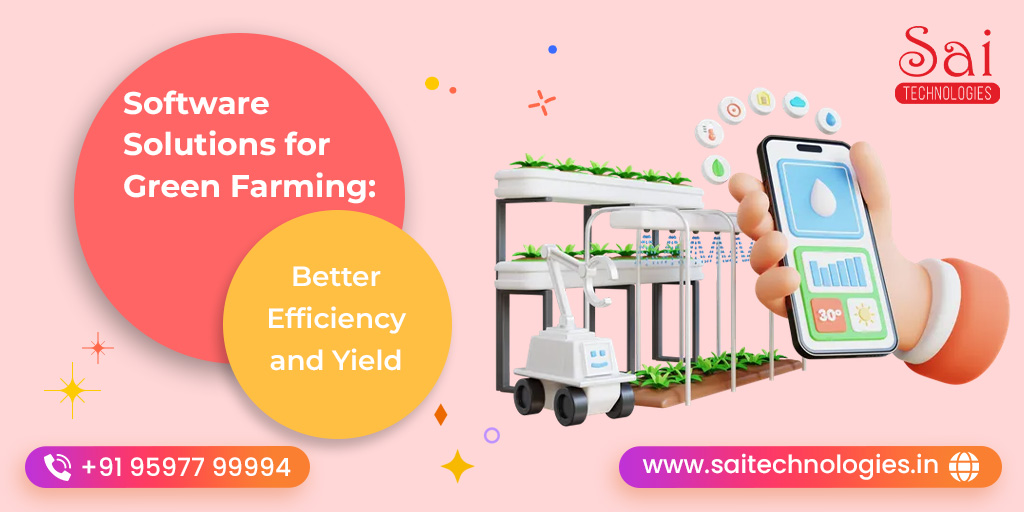Software Solutions for Green Farming
Better Efficiency and Yield

Solutions for green farming software: Improved Productivity and Profitability Introduction In this age of technological progress, agriculture—the foundation of human civilization—is undergoing a radical transformation. In order to increase yield and efficiency, cutting-edge software solutions are being incorporated into green farming, which places an emphasis on environmentally friendly and sustainable practices. This blog looks at various software solutions that are increasing the profitability, sustainability, and productivity of green farming.
The Significance of Green Cultivating
Green cultivating, otherwise called practical horticulture, centers around creating food in manners that are smart for the climate, monetarily suitable, and socially capable. Green farming cannot be overstated in its significance. It safeguards the climate by limiting the utilization of unsafe synthetic substances, advancing biodiversity, and monitoring normal assets. Monetarily, it lessens costs related with inputs like composts and pesticides, working on the drawn out practicality of cultivating. Socially, it guarantees fair treatment and great working circumstances for ranch laborers, supporting nearby networks.
The Job of Innovation in Green Cultivating
The combination of innovation in horticulture isn't new, yet its job in green cultivating is especially vital. Farmers can use technology to better use their resources, reduce waste, and increase productivity. GPS and Internet of Things (IoT) devices are used in precision agriculture to precisely monitor and manage crops. Information examination, including large information and simulated intelligence, assists in anticipating with enduring examples, bug episodes, and harvest yields. Robotized apparatus like robots, mechanical reapers, and computerized farm haulers increments productivity and diminishes work costs. Blockchain innovation guarantees straightforwardness and discernibility in the store network, advancing fair exchange and diminishing extortion.
Key Green Farming Software Solutions Farm Management Software (FMS) is a comprehensive tool that enables farmers to plan, monitor, and analyze all farm activities. It integrates crop planning, resource management, financial management, compliance management, and other functions. Trimble Ag Software, which offers tools for field record keeping, fleet management, and precision agriculture, and Agrivi, which provides end-to-end farm management solutions, are two examples.
Software for precision agriculture The software for precision agriculture makes use of AI, IoT, and GPS to improve farming methods. Variable rate technology (VRT) and yield mapping are part of it. The John Deere Operations Center and the Climate Corporation FieldView are two examples of tools for collecting, analyzing, and managing data to improve farm operations.
IoT Solutions for Smart Farming The Internet of Things (IoT) connects various farm devices, making it possible to control and monitor them in real time. Applications incorporate brilliant water system frameworks, animals checking, and nursery mechanization. CropX and Allflex Animals Insight are models giving soil sensors and investigation to effective water system the executives and creature checking arrangements, individually.
Information Examination and man-made intelligence in Cultivating
Information investigation and simulated intelligence are changing green cultivating by giving experiences that drive independent direction. Predictive analytics, image recognition, and automated decision support are provided by these technologies. Examples of AI-driven insights for optimizing irrigation, fertilization, and pest control include Taranis and Prospera, which use high-resolution imagery and AI to monitor crop health and identify issues early.
Transparency in the Agricultural Supply Chain Thanks to Blockchain Technology, Transparency and Traceability are Guaranteed. By transparently disclosing product origins, it provides traceability and fosters consumer trust. IBM Food Trust and TE-FOOD are models involving blockchain to upgrade straightforwardness and proficiency in the food store network.
Studies of Cases:
Fruitful Reconciliation of Programming in Green Cultivating
- A grape plantation in California carried out accuracy horticulture programming to improve its tasks. The vineyard continuously monitored soil moisture, temperature, and vine health with the help of weather stations, drones, and soil sensors. Increased yield and decreased water consumption were achieved as a result of the collected data's contribution to informed decisions regarding fertilization, pest control, and irrigation.
- A rice ranch in India took on a shrewd water system framework controlled by IoT innovation. The framework utilized soil dampness sensors and climate information to computerize water system plans, prompting a critical decrease in water utilization and further developed crop wellbeing, bringing about expanded yield and diminished water use.
- A blockchain-based system was implemented by a Colombian coffee cooperative to track the journey of coffee beans from farm to cup. Transparency and traceability were provided by the system, ensuring that farmers received fair compensation and that consumers could verify where their coffee originated. Farmers' incomes increased as a result of this initiative, as did consumer trust.
- Despite the numerous advantages that software solutions provide, there are obstacles to be aware of. High starting expenses can be an obstruction to executing trend setting innovations. Ranchers need preparing to successfully utilize these advancements, and shielding delicate information from digital dangers is vital. Green farming seems to have a bright future in spite of these difficulties. Agriculture will continue to be transformed by emerging technologies like blockchain, artificial intelligence, and drones. Climate-resilient farming, autonomous farming, and sustainable inputs are important trends to keep an eye on.
Conclusion
Green farming is being transformed by software solutions, making it more sustainable, productive, and efficient. These technologies, which range from IoT and precision agriculture to data analytics and blockchain, are assisting farmers in optimizing resources, reducing waste, and increasing yields. The integration of cutting-edge software solutions will be crucial to our future efforts to address food security and environmental sustainability issues. Farmers will benefit from these innovations as well as a healthier planet and a more resilient food system if they embrace them.

